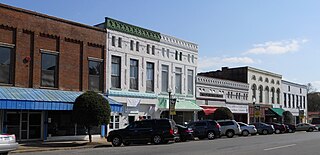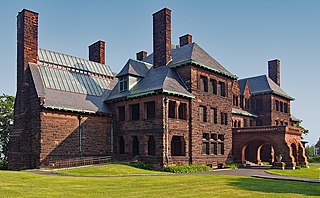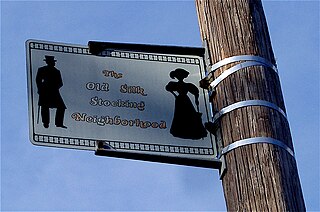
Talladega is the county seat of Talladega County, Alabama, United States. It was incorporated in 1835. At the 2020 census, the population was 15,861. Talladega is approximately 50 miles (80 km) east of one of the state’s largest cities, Birmingham.

Oregon Hill is a historic working-class neighborhood in Richmond, Virginia. Oregon Hill overlooks the James River and Belle Isle, and provides access to Hollywood Cemetery. Due to the neighborhood's proximity to the Monroe Park Campus of Virginia Commonwealth University, the neighborhood is sometimes referred to as a student quarter because of its high college student population.

The James J. Hill House in Saint Paul, Minnesota, United States, was built by railroad magnate James J. Hill. The house, completed in 1891, is near the eastern end of Summit Avenue near the Cathedral of Saint Paul. The house, for its time, was very large and was the "showcase of St. Paul" until James J. Hill's death in 1916. It is listed as a U.S. National Historic Landmark, operated by the Minnesota Historical Society. It is also a contributing property to the Historic Hill District.

Talladega College is a private historically black college in Talladega, Alabama. It is Alabama's oldest private historically black college and offers 17 degree programs. It is accredited by the Southern Association of Colleges and Schools.

The James Whitcomb Riley Museum Home, one of two homes known as the James Whitcomb Riley House on the National Register of Historic Places, is a historic building in the Lockerbie Square Historic District of Indianapolis, Indiana. It was named a National Historic Landmark in 1962 for its association with poet James Whitcomb Riley (1849-1916), known as the "Hoosier poet".

The Cummins School is a historic former school building in Cincinnati, Ohio, United States. Built in 1871 in the neighborhood of Walnut Hills, it was later used as a model for the construction of other city school buildings.
Silk Stockings is a 1955 stage musical.

Kenworthy Hall, also known as the Carlisle-Martin House, Carlisle Hall and Edward Kenworthy Carlisle House, is a plantation house located on the north side of Alabama Highway 14, two miles west of the Marion courthouse square. It was built from 1858 to 1860 and is one of the best preserved examples of Richard Upjohn's distinctive asymmetrical Italian villa style. It is the only surviving residential example of Upjohn's Italian villa style that was especially designed to suit the Southern climate and the plantation lifestyle. It has a massive four-story tower, windows of variable size and shape with brownstone trim, and a distinctly Southern division of family and public spaces. The building was designed and constructed for Edward Kenworthy Carlisle as his primary family residence and the centerpiece of his 440-acre (1.8 km2) estate. It, along with some of its surrounding ancillary structures, was declared a National Historic Landmark in 2004. The house and a purported ghost are featured as a short story in Kathryn Tucker Windham's 13 Alabama Ghosts and Jeffrey.

The Conde–Charlotte House, also known as the Kirkbride House, is a historic house museum in Mobile, Alabama. The earliest section of the building, the rear kitchen wing, was built in 1822. The main section of the house was added a few decades later and is two and a half floors. The entire structure is constructed of handmade brick with a smooth stucco plaster over the exterior.

The Old Silk Stocking Neighborhood is the historic district near downtown Kokomo, Indiana, and the Westside Business District. In 1886, natural gas was discovered in north central Indiana. The area exploded with people, who then developed the neighborhood. This historic area of town was the place where lawyers, doctors, industrialists and even a mayor would come to build their turn of the century residences.

Hawthorne, also known as the Browder Place, is a historic Italianate plantation house and historic district in Prairieville, Alabama, USA. This area of Hale County was included in Marengo County before the creation of Hale in 1867. Hawthorne is included in the Plantation Houses of the Alabama Canebrake and Their Associated Outbuildings Multiple Property Submission. It was added to the National Register of Historic Places on July 7, 1994, due to its architectural significance.

The Pfau–Crichton Cottage, best known as Chinaberry, is a historic cottage in Mobile, Alabama. The 1+1⁄2-story, wood-frame, Gulf Coast cottage was completed in 1862. The house was built by the Pfau family, but its best known resident was Miss Anne Randolph Crichton, known for the elaborate gardens that she developed on the property. She enlisted in the Navy at the outbreak of World War I and continued her service until retirement, in the 1950s. She traveled extensively in Europe during the 1930s, maintaining scrapbooks that recorded her visits to various art museums, gardens, and monuments. She was the last direct descendant of Hugh Randolph Crichton, the founder of the Mobile County town of Crichton. The house was added to the National Register of Historic Places on October 18, 1984, as a part of the 19th Century Spring Hill Neighborhood Thematic Resource listing of well-preserved buildings that represent the historical development of what was once the village of Spring Hill.

The Michigan Bell and Western Electric Warehouse is a former commercial warehouse building located at 882 Oakman Boulevard in Detroit, Michigan. It was listed on the National Register of Historic Places in 2009. It is now known as the NSO Bell Building.

The Joseph Carpenter Silversmith Shop is a historic building that was built between 1772 and 1774 on the green in Norwichtown, now a section of Norwich, Connecticut. It is a 30 feet (9.1 m) by 24 feet (7.3 m) 1+1⁄2-story clapboarded building with a gambrel roof. The interior has a single brick chimney that was used for the forge, but it has been modified and adapted for modern use with modern doors, electric lighting and heat, and a disappearing overhead stairway that leads to the attic. Joseph Carpenter (1747–1804) was a successful of silversmith, clockmaker, and pewterer, and shared the building with his brother, a merchant. The shop was added to the National Register of Historic Places on October 6, 1970, and was listed as a contributory property for the Norwichtown Historic District on January 17, 1973.

The George Stumpf House is a historic residence in Indianapolis, Indiana, United States. Located along Meridian Street on the southern side of the city, it was started in 1870 and completed in 1872.

Mount Ida, also known as the Walker Reynolds House, was an antebellum mansion, built in the Greek Revival style beginning in 1840 by Walker Reynolds, between Sylacauga and Talladega in rural Talladega County, Alabama, United States.

The Silk Stocking District is a historic district in the city of Talladega, Alabama, USA. It was listed on the National Register of Historic Places on December 13, 1979. Architectural styles include Queen Anne, Classical Revival, Colonial Revival, American Craftsman, and other late Victorian types. The district covers 113 acres (46 ha) and contained 120 contributing properties when first listed.

Alpine is a historic plantation house in Alpine, Alabama, United States. Completed in 1858, the two-story Greek Revival-style house was built for Nathaniel Welch by a master builder, Almarion Devalco Bell. The wood-frame house has several unusual features that make it one of the more architecturally interesting antebellum houses in the state. These features include the foundation materials, interior floor-plan, and the window fenestration.

The Madison Gas and Electric Company Powerhouse in Madison, Wisconsin is a Neoclassical-style structure built in 1902 by Madison Gas and Electric to house its gas-powered electrical generator. In 2002 historic parts of the complex were added to the National Register of Historic Places.

The Welch-Averiett House, in Talladega County, Alabama near Sylacauga, Alabama, dates from 1830. It was listed on the National Register of Historic Places in 1986. The listing included four contributing buildings on 44 acres (18 ha), on a land parcel of about 1,000 acres (4.0 km2).




















